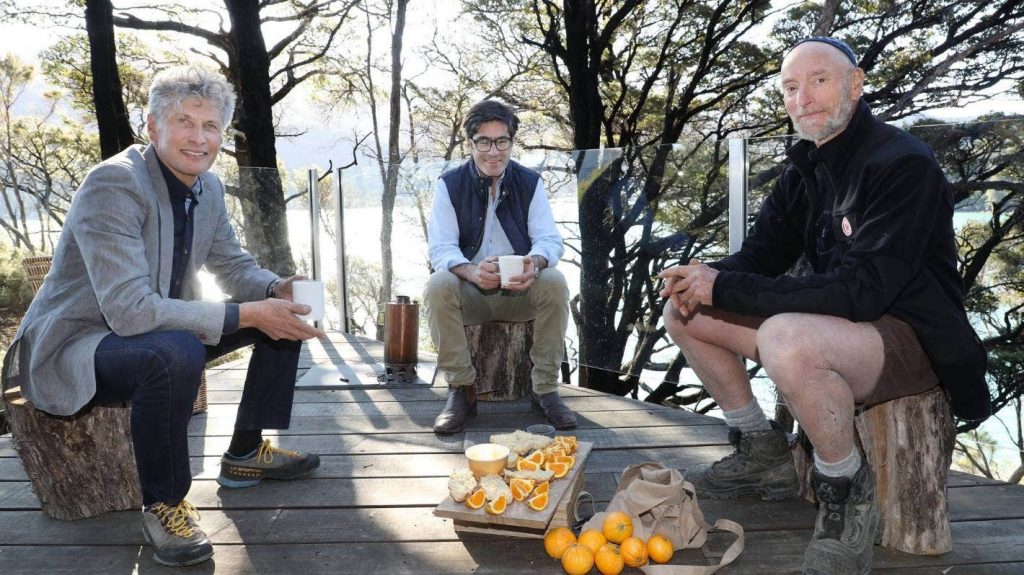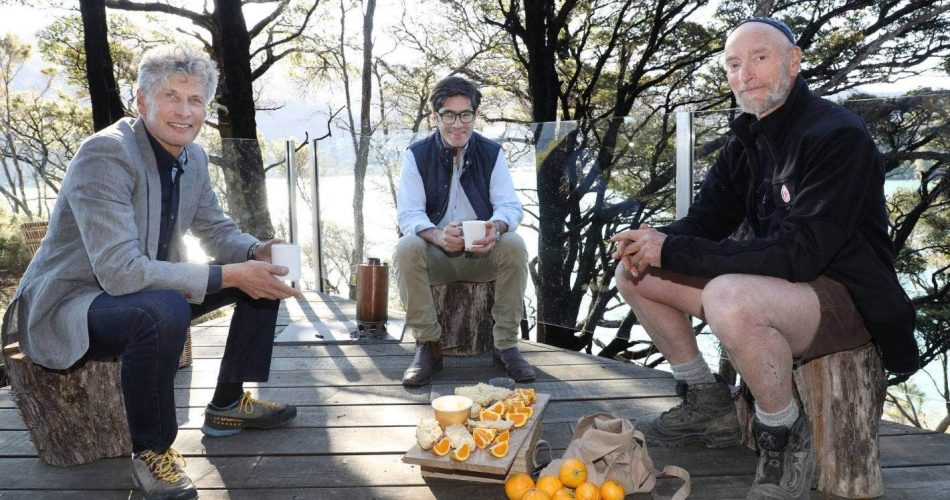While the news of the hour is that architect Chris Moller has left Grand Designs NZ (oh no!), and that they have not got a replacement yet (actually, they do, but I’m not going to tell you who), the REAL big issue – the news of the next decade or two or three or five – is that NZ is going to start to get serious about our commitment to the Climate Accord in Paris, and actually make some steps to do what we always said we would do. Its not within the capacity of the Fish to look at all the aspects – but there are some obvious targets that we can discuss. From the Stuff report of what Ardern said:
Housing
- New homes one-third more energy efficient by 2035
- No new natural gas connections to the network or bottled LPG connections after 2025
- Ageing gas heating and hot water systems switch to electric or biomass when they’re replaced
- By 2050, existing natural gas in buildings will be phased out
- Plan our cities denser
Heat pumps are already cheaper for heating homes than natural gas, and electric hot water is comparable, the commission said. Commercial buildings and houses need to up their insulation and get more energy-efficient – leaving more clean energy for transport and energy. Housing needs to get denser on transport routes to give people better access to trains, buses and cycling.
Transport
- Lower bus, train and ferry fares for under-25s and other groups
- No new or imported petrol and diesel vehicles, as early as 2030
- Feebate or subsidy for electric cars, which could be bought in bulk to boost supply
- More car-sharing and rental schemes for EVs
- More EV charging stations
- Electrify major railway lines
- More working-from-home
By 2027, half of all new cars and motorbikes will need to be electric, and we’ll need to cut off petrol and diesel imports shortly after that, the commission said. Petrol, diesel and aviation fuel will need to contain an increasing proportion of biofuel. We’ll need to walk, cycle and hop on public transport far more often, and drive less – and the Government should divvy up its transport spending accordingly, it said.
Manufacturing
- No new coal boilers, as soon as possible
- Phasing out existing coal use
- More biomass, such as wood, and (potentially) hydrogen to replace fossil fuels
For manufacturing processes needing temperatures under 300C, it’s relatively affordable to switch to electrical or wood-fired boilers, the commission said. Wood waste from a growing number of tree plantations could be put to use. Coal boilers need to be the first priority – the commission wants to save 1.4 million tonnes of emissions each year by 2028. It proposes the Government give businesses cash to make the switch. For higher-temperature processes, such as concrete and steel, we’ll need to decide whether to wait for low-emissions tech to be invented, try to find low-carbon solutions in New Zealand, or switch to lower-carbon overseas imports. The commission sees no future for aluminium in Southland or methanol in Taranaki. However, production for all other goods can continue at current levels, the commission said.
Electricity
- No more coal-fired generation at Huntly, by the end of the decade
- More large-scale wind and solar built in the early 2020s, then a pause after Tiwai closes
- More household and community power generation
- Geothermal power stations releasing high levels of greenhouse gas close before 2030
The drawn-out exit of our largest power consumer, the Tiwai aluminium smelter, is causing uncertainty for rapid solar and wind expansion, it said. The sooner there’s an exit date, the better for planning a low-carbon future, suggested the commission. Even as demand grows, the grid will get greener: up to 95 per cent of electricity will be renewable in the 2030s. By 2035, we’ll need 20 per cent more electricity than we did in 2018, to power cars and factories. Since electricity is just one form of energy, the commission recommends thinking of it together with energy used in manufacturing, and aiming to green the overall mix.
Trees
- 12,000 hectares of new native forest from 2021, rising to 16,000 hectares annually by 2025 and 25,000 a year by 2030
- Native planting would stay high until 2050
- Pine trees would continue to grow until 2030 but then taper off
- We’d need to stop cutting down existing native forests from 2025
- More timber for construction, to replace steel and concrete
Despite all the talk of planting, people felling native forest is still a sizable piece of New Zealand’s emissions. As well as stopping the chop, the draft advice tells the Government to create incentives to create new, permanent native forests, by 31 December 2022. It could be a One Billion Trees-style grant scheme, only focussed purely on indigenous trees, not pine and indgenous, as the current scheme is. The commission also proposes giving incentives for pest control, to defend the carbon already stored in established forests from being ravaged by deer and goats. It acknowledged permanent native forestry creates fewer jobs than pine plantations, but said it could be done on steep or marginal land that was unsuitable for pine or farming and wasn’t currently employing anyone.
Farming
- Herds would shrink by 15 per cent, compared with 8 to 10 per cent without adopting the budgets
- By 2030, a small shift to horticulture away from dairy farming
- By 2035 milk solid production would increase slightly, and meat production would fall slightly, compared with business-as-usual
- NZ would start measuring and increasing carbon in soil, wetlands and small blocks of trees
Many farms would need to change their management style, using smaller herds, better breeding, precision fertiliser use and other tactics to keep milk and meat production the same while shrinking methane, the commission said. By doing that, farming could meet its 2030 methane target and the lower end of its 2050 target without hoped-for fixes such as a methane vaccine or low-methane cow breeding, the commission said. Low methane sheep breeding is available, and factored in.
If new technology comes along, farmers could meet the high end of the 2050 methane target, or better. Under current Government policies, methane would reduce by only 12 per cent in 2050, well short of the Zero Carbon Act’s 24 to 47 per cent range. Longer-term, things get tougher. While farming methane isn’t required to get to zero, the commissions suggested by 2100 it may need to fall between 49 and 60 per cent (below 2017 levels), to help keep the world inside 1.5C heating. That would be tough without either cutting production, or technological breakthroughs. Nitrous oxide from animal urine and fertiliser is difficult to cut, it said, but we’ll need to reduce it by at least 16 per cent by 2035.
Waste
- Catch more of the methane released from landfills
- More products to be recovered at the end of their lives by manufacturer-led schemes
- Redesign products to be reusable and recyclable, to lower manufacturing emissions
Most of the greenhouse gas from our dumps is produced when organic material, such as food, paper, and garden waste decomposes and creates methane. We’ll need to compost more of this and ensure the rest goes to landfills that capture and burn methane, the commission said.
Refrigerants
- Import restrictions on products containing greenhouse gas refrigerants
- Higher maintenance and disposal standards for refrigerants
Hydrofluorocarbons – found in fridges and air conditioners – replaced the ozone-destroying chlorofluorocarbons, but, unfortunately, they themselves are very powerful greenhouse gases. People are already phasing out bulk supplies of these gases, but the commission wants this extended to hydrofluorocarbons imported in finished products. It also wants better standards for businesses and technicians.
Emissions trading
- Shrinking supply of units available for auction, to align with the commission’s budgets
- Higher price to emit carbon, costing between $30 and $70 per tonne with increases each year
- Cash raised from selling units pays for carbon-cutting schemes
- Phase out free units offered to exporters and big polluters – but with a possible review if there’s evidence emissions are leaking to other countries
The Government already put a cap on the number of carbon credits available for countries to meet their obligations each year, and introduced auctioning. The commission wants to see more improvements.

OK – so what is within OUR grasp? Obviously not Farming, Manufacturing, Emissions trading etc – we’re focused on the Housing issue. Maybe the Transport sector too – and we can certainly do something about the Waste sector too. But probably the main takeaways from the list are a few small words that will have mighty big impacts to us: to our cities, to our readers, to our jobs:
• Plan our cities denser
• More working-from-home
• No new or imported petrol and diesel vehicles, as early as 2030
• More timber for construction, to replace steel and concrete
• More household and community power generation

All those items are giant issues in themselves, that NZ has been skirting around the outside of for years now. Apart from the builder in the picture above (Dave Kepes, aka Mr Many Hats), NZ is not really tackling these issues head on in the slightest. I’m looking forward to the challenge!
(to be continued…)





I am about to commit to building a new house for the -ive family with an up-and-coming and award-laden architectural practice. It is based on a derelict commercial site with some reusable block work. It has its own fresh water source and a long northern exposure perfect for solar – so potentially off-grid. The challenge is to design and specify in keeping with the aspirations you outline above and (unlike your typical Grand Design) keep to a budget.
140m2 for $400,000?
If you are considering a new build going off grid -either now or in the future, then plan for it to happen in the build process,
Look at things like
– a separate 12V circuit in the House to run LED lighting directly from the solar system (going from 12V to 240V and back wastes electrons) – the easiest way to do this for the future is simply leaving unused cables in the walls and roof – wires are cheap its the cost of putting it in that is expensive
– building your plumbing around a central location with hot water pies having as short run as possible…
However, Gas has often been seen as the standard “get out of jail” off grid source for water heating and cooking – to go without gas requires serious battery capacity for clod and short winter days
But whatever your choices, for a new build the cheapest form of heating is insulation….so over spec anything and everything you can to retain/capture solar gain….
Good luck …. esp in this busy construction market….
Yes – start to order materials and stock pile them now – we’re running out of everything in this country at present!
Starkive – that works out at $2857/m2 which these days is tight, but should still be achievable. Often, architects I know are looking more around $6k / m2 – so don’t expect anything fancy at that price! Are you looking at Whanganui or at Wellington? And – who is your Architect ?!
Actually, I think I know who might fit that suggestion….
On the subject of Grand Designs and Mr Moller, the comments on Stuff are interesting. Not rabid mad dog as usual: the commenters actually seem to be human. Take this one for instance, from Kane656:
“It would have been an unenviable task to follow in the footsteps of Kevin McCloud but Chris really made that role his own for the NZ version of GD. His inquisitiveness, enthusiasm and warmth was infectious and made for compelling viewing. Sometimes creative types – and I am one myself – can be dismissive, obsessive and inarticulate but he was none of these. Best wishes for your future endeavours Chris.”
or this one, from Ucht Menot:
“Not just an architect but a quintessentially appropriate tv show host. Shouldn’t be surprised if other gigs follow in due course.”
and one more, from Fannington:
“All good things come to an end, I guess, but it’s still a shame to see the finish of one of the very best shows ever produced in NZ. And Moller’s commitment to focus on the people and the architecture, rather than hype and faked drama, made the show so much better than it’s UK counterparts. Congratulations to Chis and the team!”
Starkive have a nosey at this
https://digitalsolarheat.com/
Solar gains stored in mass stones in well-insulated basement/subfloor – thing takes about a year to heat up apparently but a good idea from what i hear
GreenW is right about spare cables too
Have a look into Trombe walls as well
As for materials my PM has a alum window manufacturer mate who has just bought in 400k worth of window alum and hardware in anticipation of shortages
We are getting all of our subs in a new build to get their stuff into secure storage that the client is paying for and we haven’t poured our first groundbeam yet
Paint,sinks,roofing,get it all and the client will pay for it
It’s real
“…the series will be hosted by British-born architect Tom Webster, who will replace Chris Moller.”
https://www.stuff.co.nz/entertainment/tv-radio/124130111/grand-designs-new-zealand-moves-to-tvnz-1-new-host-tom-webster-to-replace-chris-moller
Sounds like he’s definitely got the credentials.
“New host Webster has worked for Google, as well as overseeing the master planning of work at Windsor Castle in the UK.
Webster also recently collaborated on the Hotel Britomart, New Zealand’s first five Green Star hotel in downtown Auckland.”
The commission on transport has been vastly feeble, as this excellent piece on Greater Auckland makes clear – a great
read https://www.greaterauckland.org.nz/2021/02/11/double-is-nothing/?mc_cid=4a1f3ca49b&mc_eid=43829bd14a
Aah, back to the subject at hand – thank you Isabella. It’s interesting how on-topic the GreaterAuckland writers are – and how off-topic the Eye of the Fish is by comparison.
This is a post that I’m going to be returning to many times – when I have time. Just a bit short on time at the moment – but isn’t that the same for all of us, all over the world? If only we had started in 1972, when the hippies were warning us. Before you were even born, I’m sure, but they were trying to warn us. Warn the world. And the world took no notice. Almost definitely too late to stop it now. But we should still try, yes?